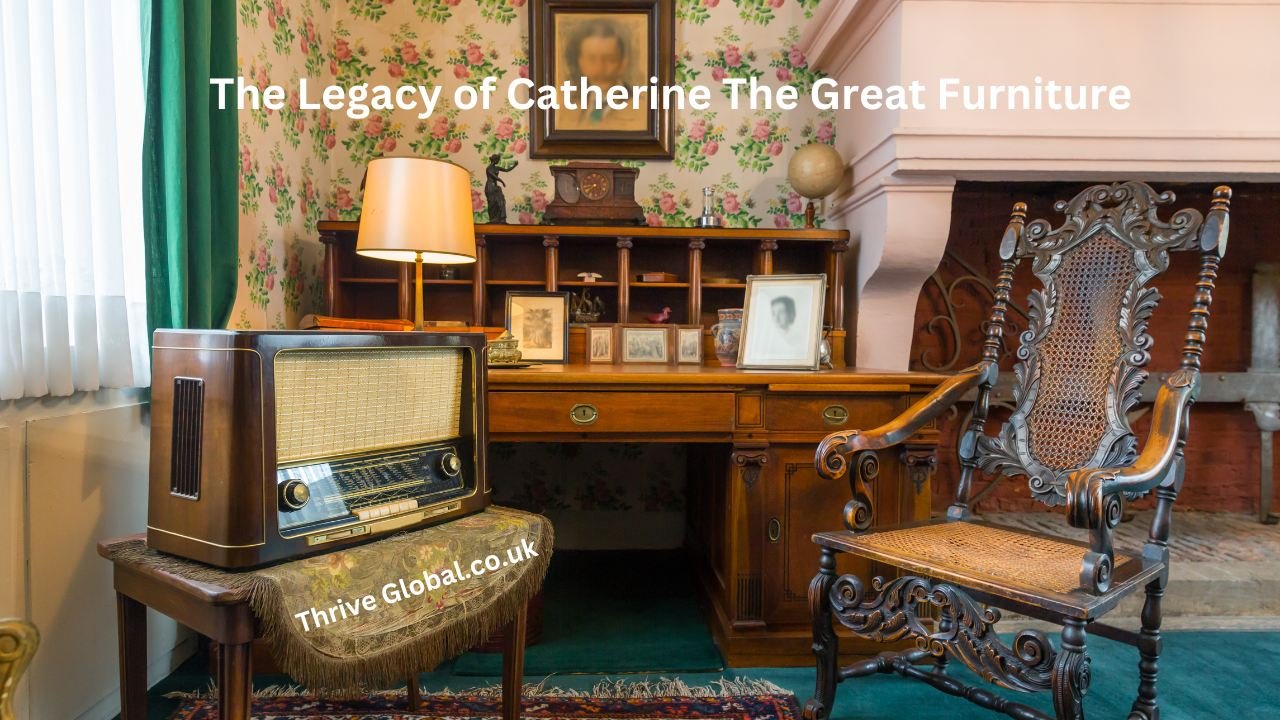Introduction to Catherine the Great and her Furniture Legacy

Catherine the Great, whose name echoes through history, was not just an extraordinary ruler of Russia but also a visionary patron of the arts. Her reign in the 18th century ushered in a golden age for Russian culture, marked by remarkable advancements in literature, music, and architecture. Among her many contributions to this cultural renaissance is an astonishing furniture legacy that still captivates admirers today.
Imagine walking through ornate halls with stunning pieces crafted from exquisite materials and showcasing unparalleled artistry. Each item tells its own story—reflecting Catherine’s opulence while embodying the skill and creativity of master artisans. From lavish thrones to intricately designed cabinets, Catherine’s collection represents more than mere decoration; it symbolizes power, elegance, and innovation.
In exploring Catherine the Great’s furniture legacy, we delve into iconic pieces that continue to inspire designers worldwide. These treasures reveal insights into historical significance and artistic mastery—a blend that resonates even in modern design aesthetics. Join us as we uncover these timeless masterpieces that have stood resilient against time’s relentless tide!
Catherine the Great’s furniture
Catherine the Great’s furniture collection is a testament to her reign and vision. Each piece reflects not just luxury but also functionality and style.
Various European styles influenced her taste in design. Rococo, Neoclassical, and even Baroque elements can be found throughout her renowned collection. This blend created an aesthetic that was uniquely Russian yet undeniably sophisticated.
Among the most striking items are ornate chairs adorned with gilded details and intricate upholstery. These pieces were crafted by skilled artisans who poured their creativity into every detail.
The significance of these furnishings goes beyond mere decoration; they served as symbols of power and prestige during a transformative era in Russia’s history. Catherine understood that beautiful spaces inspired loyalty among her court members.
Today, Catherine’s furniture inspires designers worldwide. Its enduring legacy showcases the intersection of art and utility in interior design.
The Magnificence of the Diamond Orlov Throne
The Diamond Orlov Throne is a testament to the luxury and artistry of Catherine the Great’s reign. Crafted in 1776, it was designed not just for comfort but also as a symbol of imperial power.
Adorned with over 1,000 diamonds, its allure is undeniable. Each gem reflects light beautifully, creating an enchanting atmosphere fit for royalty. The intricate woodwork showcases exceptional craftsmanship—the details are mesmerizing.
Catherine commissioned this piece to embody her vision of enlightened monarchy. It was more than mere furniture; it became integral to state ceremonies and gatherings.
Today, this majestic throne resides in the State Hermitage Museum in St. Petersburg. Visitors gaze upon it, captivated by its historical significance and stunning beauty—a true crown jewel among Catherine the Great’s furniture legacy.
The Intricacy of the Tula Enamel Cabinet
The Tula Enamel Cabinet is a testament to the artistry of 18th-century Russian craftsmanship. Adorned with intricate enamel work, this piece reflects exceptional detail that captivates anyone who sees it.
Each panel showcases vibrant hues and delicate patterns, merging functionality with artistic expression. The cabinet’s design is not just beautiful; it’s also steeped in cultural significance, representing the luxury of Catherine’s court.
Crafted using techniques honed over centuries, artisans poured their skills into every curve and embellishment. This dedication transforms a simple storage unit into a prized possession.
Today, the Tula Enamel Cabinet remains a favored subject for historians and art enthusiasts. It illustrates how furniture can transcend utility to become an enduring symbol of elegance and sophistication in design history.
The Legacy Continues: How These Pieces Have Been Preserved and Displayed
Catherine the Great’s furniture legacy has been meticulously preserved over the centuries. Institutions like the State Hermitage Museum in St. Petersburg house these magnificent pieces and showcase their historical significance.
The careful restoration process ensures that each item retains its original splendor. Experts use traditional techniques to maintain authenticity while integrating modern conservation methods to protect against wear and tear.
Exhibitions often feature these iconic artifacts, allowing the public to glimpse 18th-century opulence. Curators present the furniture and the context regarding its creation and use within Catherine’s court.
Traveling exhibitions expand access beyond Russia, bringing Catherine’s treasures to international audiences eager for a taste of imperial history. This dedication to preservation keeps alive the story of one woman’s extraordinary vision for beauty and grandeur in design, ensuring that Catherine’s influence remains vibrant today.
The Influence of Catherine’s Furniture on Modern Design
Catherine the Great’s furniture legacy transcends time, remarkably influencing contemporary design. The elegance and luxury of her pieces inspire modern interior aesthetics, merging functionality with artistry.
Designers today often draw from the ornate details found in Catherine’s collection. Curvilinear forms and lavish embellishments are coming back in various styles, from baroque to eclectic interiors.
Sustainable practices also echo through these historical designs. Many artisans look back to Catherine’s emphasis on craftsmanship, valuing quality over mass production. This approach enhances not only the beauty but also the longevity of each piece.
Color palettes inspired by her luxurious furnishings can be seen across modern homes. Rich hues and intricate patterns create spaces that feel both sophisticated and inviting.
Catherine’s vision for elegant living continues to guide contemporary designers as they blend history with innovation.
Conclusion: Why These Treasures Are Still Relevant Today

Catherine the Great’s furniture remains a testament to exquisite craftsmanship. Each piece tells a story, reflecting an era rich in culture and artistic innovation.
Today, these treasures inspire modern designers. Their intricate details and bold designs offer fresh ideas for contemporary interiors.
Furthermore, they serve as reminders of Russia’s imperial history. As we navigate through modern aesthetics, understanding this legacy enriches our appreciation for historical influences in design.
Collectors and enthusiasts continue to seek pieces that echo Catherine’s grandeur. They embody timeless elegance that transcends trends.
These artifacts connect us with the past while igniting creativity for future generations. Catherine the Great’s furniture has an undeniable lasting impact, making it a cherished relic worth preserving in today’s world.
Introduction to Catherine the Great and her impressive furniture collection
Catherine the Great, Empress of Russia from 1762 to 1796, was a visionary leader who transformed her empire. Her reign is often associated with cultural enlightenment and significant advancements in the arts.
Catherine’s furniture collection symbolizes luxury and artistry among her many contributions. She amassed an impressive array of pieces reflecting European sophistication and Russian heritage.
Each item tells a story—crafted not just for utility but also for grandeur. Influenced by French Rococo and Neoclassical styles, her selections were deeply personal yet strikingly universal.
Catherine understood the power of aesthetics; she believed furniture could elevate spaces to something extraordinary. This passion resulted in iconic masterpieces that continue to captivate collectors and historians today.
Her legacy lives on through these exquisite creations, which remain testaments to an era defined by elegance and innovation.
The Significance of Furniture in 18th-Century Russia
Furniture in 18th-century Russia was more than just functional; it symbolized wealth and power. The luxury of the nobility was often displayed through intricate designs and luxurious materials.
Craftsmanship reached new heights as artisans crafted pieces adorned with gold leaf, precious gems, and delicate fabrics. These creations were not merely tools for everyday life but statements of status.
The shift from practical to decorative furniture reflected broader social changes. As Western influences permeated Russian culture, styles evolved to embrace Baroque and Rococo aesthetics.
This period also marked a growing interest in interior design as aristocrats sought to create stunning living spaces that showcased their taste and sophistication.
Each piece told a story, embodying the cultural richness of its time while serving as an artistic expression of identity. Such significance made furniture integral to understanding the history and heritage of 18th-century Russia.
Iconic pieces from Catherine the Great’s collection
Catherine the Great’s furniture collection is a treasure trove of artistry and historical significance. Among its standout pieces is the flamboyant Diamond Orlov Throne, adorned with over 1,000 diamonds. This throne served as a seat of power and symbolized Catherine’s reign and aspirations.
Another remarkable gem from her collection is the Tula Enamel Cabinet. Its intricate designs showcase masterful craftsmanship that blends utility with art. Each drawer tells a story, reflecting Russian culture and European influences during an era of transition.
These iconic pieces represent more than just furniture; they embody Catherine’s vision for Russia—an empire between tradition and modernity. Through each carving and embellishment, one can trace the rich narratives woven into the fabric of history.
The craftsmanship and design of each piece
Catherine the Great’s furniture collection reflects extraordinary craftsmanship and design. Each piece was meticulously crafted, embodying the artistry of 18th-century artisans.
Intricate carvings and gilded accents adorn many items, showcasing the luxury that characterized her reign. Rich materials such as mahogany, walnut, and fine textiles add depth to each creation.
The designs often blend functionality with elegance. Chairs feature graceful curves, while tables display elaborate inlays that tell stories through their patterns.
Moreover, skilled artisans employed traditional techniques passed down through generations. This dedication to detail ensures every item is not just furniture but a work of art.
From royal thrones to delicate cabinets, each piece carries its narrative. They testify to Catherine’s vision for beauty and sophistication in her courtly life.
The historical and cultural influences behind the furniture
Catherine the Great’s furniture reflects a rich tapestry of historical and cultural influences. The 18th century was a period of immense change in Russia, marked by the embracing of European styles.
French Rococo designs heavily influenced her collection. Ornate curves and intricate detailing became hallmarks of her exquisite taste. This fusion symbolized Russia’s quest for modernization while still honoring its heritage.
Additionally, Catherine sought to legitimize her reign through art and culture. She commissioned artisans from various backgrounds, blending local craftsmanship with foreign techniques. Each piece tells a story—a dialogue between East and West.
Using luxurious materials like mahogany, gilded bronze, and fine textiles showcases an appreciation for luxury. These choices reflect wealth and convey power and sophistication during a transformative era in Russian history.
How these pieces have stood the test of time and continue to inspire modern design

Catherine the Great’s furniture has transcended centuries, remaining a beacon of elegance and craftsmanship. Each piece tells a story that resonates today.
The meticulous artistry in creating these items captures the essence of 18th-century luxury. It reflects not just functionality but an extravagant lifestyle that many still admire.
Modern designers often draw inspiration from her collection. The curves, colors, and intricate details influence contemporary aesthetics. These attributes create a seamless blend between history and modernity.
Furthermore, these pieces’ enduring appeal lies in their cultural significance. They serve as reminders of Russia’s rich heritage while appealing to global tastes.
Today’s interior spaces embrace elements reminiscent of Catherine’s time—bold patterns paired with luxurious fabrics evoke sophistication rooted in tradition. This fusion showcases how timeless designs can seamlessly integrate into current trends without losing their historical charm.
Catherine the Great’s furniture
Catherine the Great’s furniture collection reflects her immense influence and vision for Russia. Each piece tells a story of luxury and artistry, designed to impress guests and rival nations.
Her passion for aesthetics was evident in every selection. From gilded chairs to intricate tables, these furnishings were more than functional; they symbolized power.
The craftsmanship behind Catherine’s furniture is unparalleled. Artisans employed advanced techniques that blended European styles with Russian traditions. The result? Timeless pieces that continue to captivate enthusiasts today.
Many items from her collection are housed in palaces like Tsarskoye Selo, where visitors can admire their splendor firsthand. Their preservation showcases a commitment to history and culture, allowing generations to experience the glamour of the 18th century.
Catherine understood that each item served as an extension of her persona—regal, sophisticated, and ambitious—a legacy still felt in contemporary design circles.
Conclusion: Reflection on Catherine, the
Catherine the Great’s furniture represents more than just aesthetic appeal. It embodies a rich history, reflecting the cultural tapestry of 18th-century Russia. Each piece tells a story of craftsmanship, design ingenuity, and royal ambition. The Diamond Orlov Throne dazzles with its luxury, while the Tula Enamel Cabinet captivates with intricate details.
These treasures have not only been preserved through time but continue to inspire modern designers who draw from Catherine’s vision. Her legacy is evident in contemporary works that value both beauty and functionality.
Today’s appreciation for these iconic pieces underscores their timeless relevance. They remind us of an era where art met practicality in grand spaces. The world still marvels at Catherine the Great’s furniture—not merely as relics of history but as symbols of enduring elegance and inspiration that resonate across centuries.



